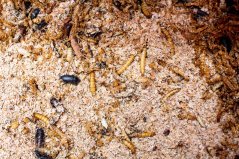
Longread
Crickets and mealworms for everyone
Insects are a source of high-quality protein and can be cultivated easily. That’s why WUR researcher Teun Veldkamp explores the possibilities of using insects in food for humans and animals. “Insects can be cultivated on waste streams from the food processing industry, which makes them much more sustainable than fishmeal and soya.”
Will we be eating pasta and bread made from insect flour in the future? We will if Teun Veldkamp has anything to do with it, as insects are rich in protein. “There’s a worldwide demand for protein for food. In Africa, incomes are rising and that has led to an increase in the demand for meat and fish, so prices are going up steeply too. On top of that, it is debatable whether the planet can bear the burden of meeting that demand sustainably.” Traditional meat production takes up large amounts of land and natural resources, explains Veldkamp. “Here in Europe, we want lower-impact livestock farming.”
In Europe, we want lower-impact livestock farming
Insects are a good alternative to these proteins. In the European SUSINCHAIN (Sustainable Insect Chain) project Veldkamp researches the options for incorporating insects in animal feed and food designed for humans. Veldkamp is a senior researcher in Animal Nutrition at Wageningen University and Research (WUR) and specialises in insects. Because insects reproduce fast, they offer real opportunities as an alternative source of protein in animal feed. Veldkamp: “Another big advantage of insects is that you can grow them on waste streams from the food processing industry, such as vegetable remains and pulp, making them much more sustainable than fishmeal and soya, which is currently being used to feed livestock.” Moreover, insects can be cultivated locally, unlike fishmeal and soya.
Bread and pasta
The food industry is also interested in alternative sources of protein; the nutritional value of insects is comparable to that of ordinary meat. However, consumers are not at all keen on eating whole insects. But a good alternative might be to incorporate insect flour in food products such as bread and pasta.

One disadvantage of insect farming is the cost. Insects have been farmed for decades but not on a large scale. If insects are to become a realistic alternative source of protein, production needs to be scaled up for supplying large volumes with consistent quality. The aim of SUSINCHAIN is therefore to test and demonstrate innovative rearing methods that will allow a smoothly functioning, commercially viable European insect supply chain to be set up.
Cultivation methods
The project is also a seamless fit with the views of the Ministry of Agriculture, Nature and Food Quality. Veldkamp: “The ministry has drawn up a sector plan together with the insect farming sector. There is synergy between aspects of that plan and our project.”
Consumers are not at all keen on eating whole insects, so we incorporate insect flour in food products such as bread and pasta
Veldkamp: “When developing business models and examining possible markets, we look at the current state of affairs and the options for insect producers. For example, what else could we do with insects? And we also look at the issues insect farmers encounter, in terms of both legislation and rearing methods.”
The researchers are also examining various rearing techniques and ways of improving the transport of larvae and eggs. That includes the larvae of the black soldier fly, the housefly, the mealworm and the cricket. “These are the insects most commonly farmed for animal and human consumption. We look at the quantities of larvae per rearing box, the quantities of feed and the types of feed. Temperature and humidity are important when transporting eggs for the production of larvae, for example.”
Experimenting
The project also focuses on developing the technology for processing insects. The scientists are experimenting with various processing techniques. Veldkamp: “You need to dry the larvae first, getting rid of 70 per cent of the moisture, before you can turn them into insect flour. We tested techniques including microwaving, radio-frequency drying and low-energy electron beams on a variety of larvae. Those experiments yielded various products, some of which are being tested further in another work package looking at the use of insects in animal feed.”
In these experiments, various types and quantities of insect meal are added to animal feed for farmed fish, poultry and piglets. Veldkamp: “We consider aspects such as the digestibility of the meal. That information is used to put together different animal feed products. Then we look at how the animals do when fed these products. What is their growth like, how many eggs are laid, are there health effects? WUR has a great deal of experience in this area and we can put that knowledge to good use in this project.”
New food products
For the use and application of insects in food for humans, six product prototypes are being developed that will then be tried out on consumers and sensory panels. Veldkamp: “The insect meal will be incorporated in standard products such as pasta, bread and falafels. We are doing this because at this point, European consumers are not keen on eating insects that are recognisable as such — something that is more common in Asia. We are doing consumer tests in Denmark and Portugal.”

Food safety is also taken into consideration. Veldkamp: “Some people may develop an allergic reaction to mealworms, similar to a shellfish allergy. Two major allergens that have been identified are tropomyosin and arginine kinase, which are found in mealworms, shellfish, and house dust mite. Mycotoxins are also investigated; these are toxic compounds formed by fungi in agricultural crops. Certain weather conditions can lead to such high concentrations of mycotoxines in, for example, grains and nuts, that the crops cannot be used anymore for feed or food production. We investigate if insects can safely be reared on mycotoxin contaminated crops.”
Gut health
The project is now halfway — it is due to end 30 September 2023 — but there are already some specific results. Veldkamp: “When insects are incorporated in animal feed, the insect products are just as digestible as conventional protein-rich animal feed materials. In fact, insects can boost gut health and immunity in animals.”
We look at the issues insect farmers encounter, in terms of both legislation and rearing methods
Humans also appreciate insect products — when they are not recognisably insect-like. Veldkamp: “Regular dinner meals will be assessed by consumer panels in Denmark and Portugal. Of course you must state on the label that they contain insects because of possible allergies.”
A major benefit of this project is that it is giving the insect sector and WUR a lot of new knowledge. WUR already knows a lot about insect production and using insect protein in animal feed. Food safety is also a key area of research at the institute but there is always a need for more knowledge, including among practitioners. Veldkamp: “The insect farming sector is quite new and there is a real need to share know-how. That doesn’t happen enough at present. The pioneers often keep the expertise they have acquired to themselves so that they don’t lose their competitive advantage. WUR’s task is to share our knowledge with the sector as a whole. That is why we launched a stakeholder platform where partners in the insect sector can talk about their experiences and the problems they encounter.” Such a platform is more than welcome, as insect rearing companies are on the rise.
The insect farming sector is quite new and there is a real need to share know-how
And this is how the objectives of the project – replacing 20 per cent of European consumption of animal protein with insect protein – are one step closer.